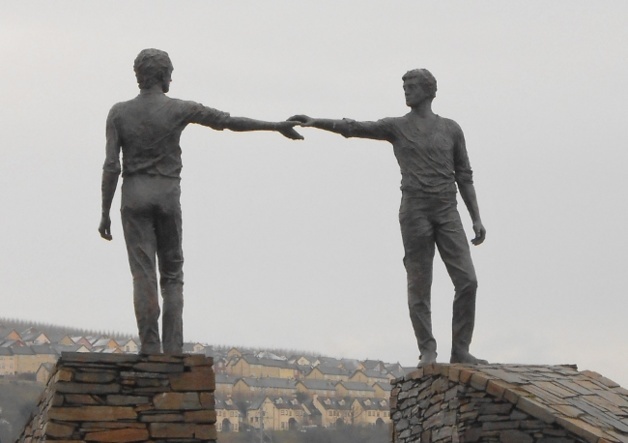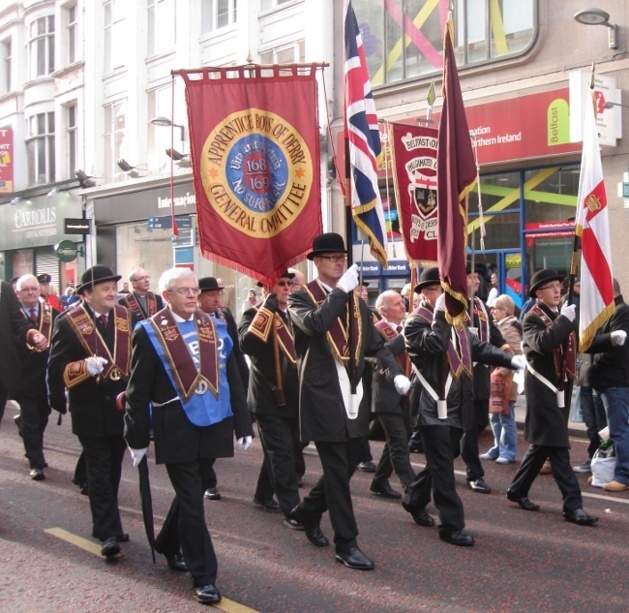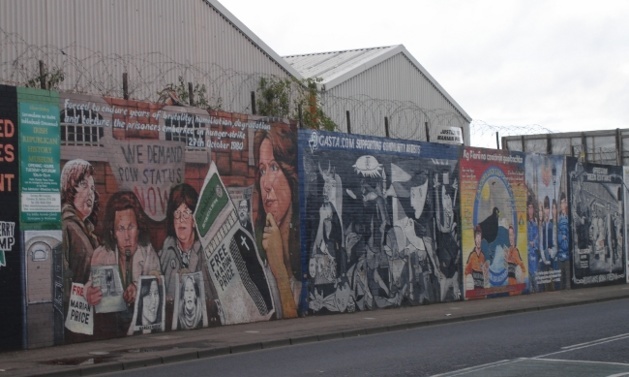
Statue entitled “Hands Across the Divide” in Derry/Londonderry | Credits : Stéphanie Escudier
Walking through the Catholic or Protestant Northern Ireland districts is always a thrilling experience. Small marble slabs dot the streets celebrating the memory of those killed during the Troubles (period of great violence, not to say civil war, extending from 1969 to 1998). But the curious will quickly see a singular fact: some dates of murders are approaching the present. 2011, 2012, 2013 ... Violence had been the everyday life in Northern Ireland for over three centuries.
These acts of violence can originally be explained by territorial rivalries illustrated by the Red Hand of Ulster presents that can be seen, for example on the flag of Ulster. The Viking legend says indeed in one version, that Northern Ireland had to return to the first man arising his hand on its territory, after a Drakkar race. One particularly avid competitor understanding that he was not going to win the race would have cut his hand to launch it on the shore, becoming the sovereign of Northern Ireland. For its wealth and its strategic location, Northern Ireland continued to be sought after since the Viking Age ... Today, it is on passage issues or properties rights that violence arose.
These acts of violence can originally be explained by territorial rivalries illustrated by the Red Hand of Ulster presents that can be seen, for example on the flag of Ulster. The Viking legend says indeed in one version, that Northern Ireland had to return to the first man arising his hand on its territory, after a Drakkar race. One particularly avid competitor understanding that he was not going to win the race would have cut his hand to launch it on the shore, becoming the sovereign of Northern Ireland. For its wealth and its strategic location, Northern Ireland continued to be sought after since the Viking Age ... Today, it is on passage issues or properties rights that violence arose.
Two Nations for one State
But the Northern Irish question crystallized on the religious issue. Since the establishment of plantations by British land grabbing in Ulster, and with the defeat of the Catholic Jacobites in 1690 at the Battle of the Boyne, the British Anglican dominated Ulster politically and economically. In 1921, the Anglo-Irish Treaty caused the separation of the six counties of Northern Ireland from the Irish Free State, which became by the adoption of the Constitution in 1937, the Republic of Ireland.
Catholics Republicans claimed the annexation of Northern Ireland to the Republic of Ireland causing the outbreak of the Civil War and being the motor of the attacks of the Irish Republican Army (IRA). To this violence, Anglicans responded with reprisals carried out by fraternities more or less structured, the most famous one being the Orange Order. The Orangemen (named after William of Orange, the winner of the Battle of the Boyne) and other fraternities, parade still regularly in the cities of Northern Ireland to remind people their power and influence.
Catholics Republicans claimed the annexation of Northern Ireland to the Republic of Ireland causing the outbreak of the Civil War and being the motor of the attacks of the Irish Republican Army (IRA). To this violence, Anglicans responded with reprisals carried out by fraternities more or less structured, the most famous one being the Orange Order. The Orangemen (named after William of Orange, the winner of the Battle of the Boyne) and other fraternities, parade still regularly in the cities of Northern Ireland to remind people their power and influence.

Parade of the Orange Order in Belfast | Credits : Fabien Aufrechter/Le Journal International
In November 2012, it is the decision of the Belfast City Council, dominated by Sinn Féin (Nationalist and Republican party), to no longer float the Union Jack on the City Hall outside of special occasions that has fire the powder causing six weeks of riots, one hundred of people arrested and 70 policemen hurt. More recently, the deviation of the Protestant parade of July the 12nd (the anniversary of the Battle of the Boyne), to prevent it to cross a Catholic area revived violence. One month later, the 9th of August, during the commemoration by Catholics of the beginning of internment without trial (which began the 9th of August 1971), Protestants attacked the manifestation and hurt more than fifty policemen with stones and pint of beer. Violence has become the preferred weapon of Protestant loyalists to the British crown to withstand the growing influence of Catholics.
The Politics of fear
This is mainly the economic crisis that explains the return of such violence: the Protestants over-represented in the industry, are more affected by its impacts than Catholics. Moreover, demographically, the hitherto more numerous than Catholics Protestants, are overwhelmed by them. The direct involvement is a political frightening to the new minority who discovers that democracy is a “dictatorship of the majority.” Violence, has changed sides when the former majority felt marginalized and therefore in danger, even if it is not the exclusivity of any side.
The religious conflict that Troubles were, yielded to violent social demands. Unemployment undermines Protestant neighborhoods like the Catholic neighborhoods. People are feeling helpless and have no faith in the future. The new "lost generation" of young people is living in the memory of violence and disorder and, lacking of anything better, blithely stones from time to time, cars of tourists coming to see the murals adorning the walls of Belfast. The situation is not similar to the Troubles, real civil war, but the Good Friday Agreement did not manage to sweep the culture of violence that characterizes Northern Ireland.
The religious conflict that Troubles were, yielded to violent social demands. Unemployment undermines Protestant neighborhoods like the Catholic neighborhoods. People are feeling helpless and have no faith in the future. The new "lost generation" of young people is living in the memory of violence and disorder and, lacking of anything better, blithely stones from time to time, cars of tourists coming to see the murals adorning the walls of Belfast. The situation is not similar to the Troubles, real civil war, but the Good Friday Agreement did not manage to sweep the culture of violence that characterizes Northern Ireland.
Breaking the wall
In 2013, the Prime Minister (Protestant) and the Vice Prime Minister (Catholic) decided by mutual agreement to destroy in ten years the walls that separates Catholics neighborhoods from Protestant's one in Belfast. If destroying these walls is a disaster in terms of heritage, it is a necessity to improve relations between Catholics and Protestants. But destroying the walls is not a solution: it is only a first step towards the social cohesion necessary for the containment of violence. But this cohesion will remain unreachable as long as a sustainable policy of appeasement and a real social policy will not be set up. Such a policy would require a consensus of the two enemies’ wings (Catholic and Protestant) of the governing coalition established by the Treaty of Saint Andrew in 2006. In the absence of such an agreement, the situation remains unsolvable.

Peace wall in Belfast | Credits : Fabien Aufrechter/Le Journal International
One example of this hopeless consensus is the situation concerning the place of the jail where were incarcerated IRA members arrested by the British police, during the trouble. While a consensus had emerged with the construction on the place of a site of memory taking the form of a Peace Center, the Prime Minister of Northern Ireland Peter Robinson suddenly changed his mind ending the project despite the fact that the European funds had already been paid. Even when the consensus is reachable, it disappeared at the last minute. The hopeless peace explains, in part, the disarray of Northern Irish.
Though, the recent violence has nothing to do with the Troubles, the removal of a flag or the deviation of a parade. This is unemployment and distress of the people that is the real problem because populations are easier to manipulate by religious groups seeking to rekindle a conflict of another time. These extremist factions, Catholics and Protestants, that benefit from the crisis, in the same way that Golden Dawn in Greece, are seeking to bring back Ireland to a not very distant past, even though most of the Irish, from the North or from the Republic, are considering that it is time for the History to be digested, that it is time for the dead to be buried and that it is time for the wounds to be healed so that the final point of the last European war of religions could be put.
Though, the recent violence has nothing to do with the Troubles, the removal of a flag or the deviation of a parade. This is unemployment and distress of the people that is the real problem because populations are easier to manipulate by religious groups seeking to rekindle a conflict of another time. These extremist factions, Catholics and Protestants, that benefit from the crisis, in the same way that Golden Dawn in Greece, are seeking to bring back Ireland to a not very distant past, even though most of the Irish, from the North or from the Republic, are considering that it is time for the History to be digested, that it is time for the dead to be buried and that it is time for the wounds to be healed so that the final point of the last European war of religions could be put.



























